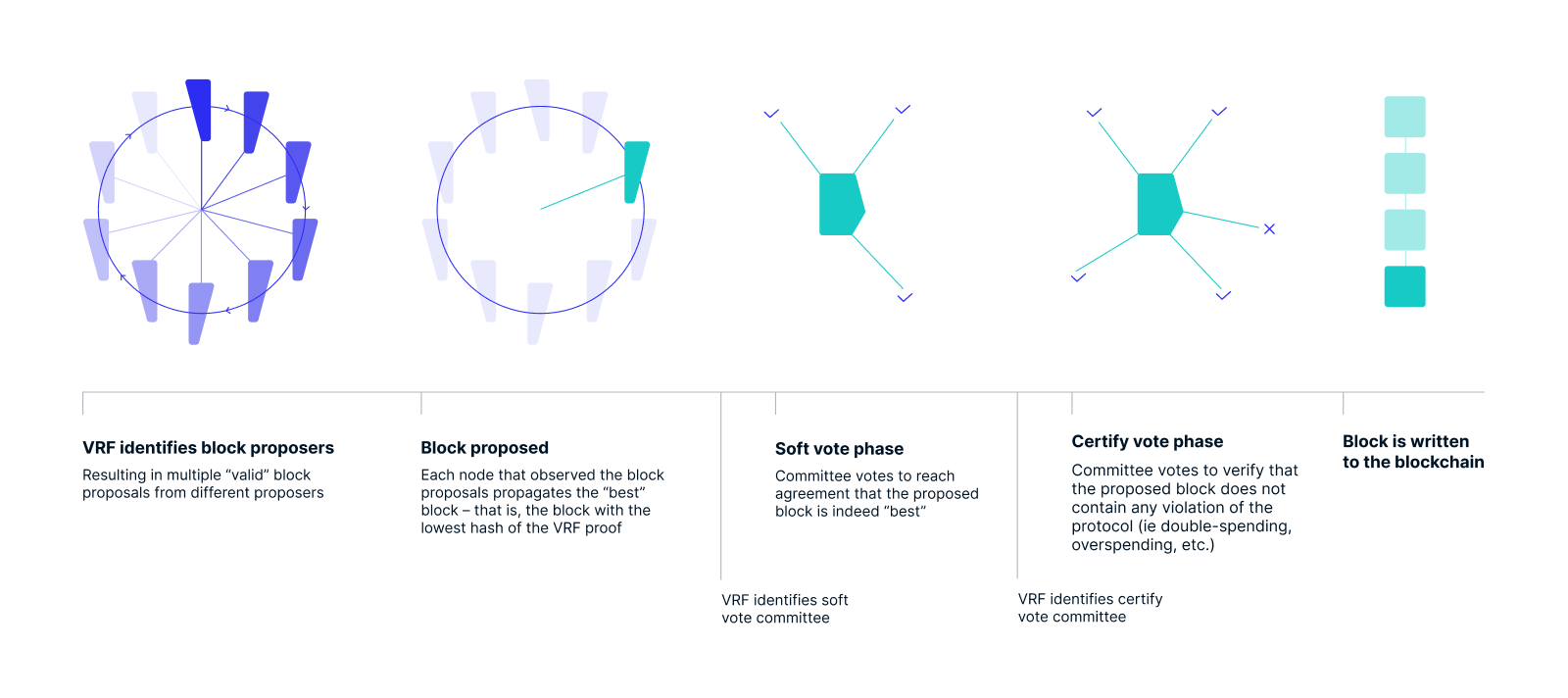The Algorand blockchain pioneered the Pure Proof-of-Stake (PPoS) consensus mechanism. Unlike other proof-of-stake (PoS) approaches where a user must stake (essentially, lock up) their tokens, on Algorand the user maintains control of their Algo at all times, since the tokens remain in the user’s wallet whilst securing the network as part of consensus.
By utilizing sophisticated cryptography, including Verifiable Random Functions (VRF) and cryptographic sortition, PPoS ensures fairness, prevents collusion, and maintains high security. The network can tolerate malicious actors, and avoid forks and double-spending, as long as a supermajority of the stake (over 2/3) is held by honest participants.
Algorand achieves scalability by electing a new block proposer and a new validator committee for each block, in less than 3 seconds. Both the block proposer and the committee members are randomly selected in a private, probabilistic and non-interactive fashion, out of all accounts that have registered online to participate in consensus, with probability based on each user’s stake.
Each user in the system can independently determine if they have been chosen as a block proposer or committee member by computing the VRF with a public and secure randomness seed. Algorand's randomness seed is a secure network-wide value that changes per block and is used as VRF input to run the cryptographic sortitions. The Algorand protocol ensures that the randomness seed, for every block, is tamper-proof and unpredictable: users willing to participate in consensus must register their “participating status” 320 blocks in advance, making sure that no malicious user could ever gain any influence on the randomness seed. Since membership selection is non-interactive, an adversary does not know which user to target until that user has finished their work.
Secure by design
PPoS is secure due to its random selection process, making it difficult for any single entity to control the network and ensures the network can achieve a scalable Byzantine Fault Tolerance (BFT) agreement on each block. To become a validator on the Algorand network, only a small stake is required, which also makes it more difficult for malicious actors to accumulate enough influence to disrupt the network. The stake in Algorand is neither locked nor delegated, which is a key differentiator of PPoS from bonded proof of stake (BPoS) and delegated proof of stake (DPoS). From a security point of view, Algorand avoids the weakness of delegated validators, since a fixed group of validators, known in advance, could easily become the target of distributed denial-of-service (DDoS) attacks. Algorand's “speak-once” model ensures two safeguards concerning DDoS attacks: first, no malicious attacker can know which node should be targeted with a DDoS in advance, and second, once the node has spoken, its role in the consensus is already fulfilled, so there would be no gain in targeting it with a DDoS.
Built for decentralization
Allowing anyone to stake Algo broadens the pool of potential validators and contributes to the level of decentralization. With a low barrier of entry to staking Algo to support the network, combined with a PPoS consensus mechanism that incorporates randomness, a system is created where power is distributed evenly and widely among a range of participants, leading to a more decentralized and secure network.
Capacity to scale
PPoS enables Algorand to handle a high volume of transactions without compromising on speed or security when the network is busy. Since PPoS relies on randomness, it eliminates the need for complex computation and competition among validators, allowing the network to consistently maintain fast transaction processing without a heavy computational overhead. The cryptographic sortition, at the core of the Algorand consensus, is implemented through VRFs in such a way that the VRF is computed once, regardless of the amount of Algo at stake: the block proposer or committee election is therefore scalable and lightweight, with minimal hardware requirements compared to other consensus mechanisms. Moreover, the time constraints (lambdas) of the Algorand consensus are adaptive. This allows the Algorand network to dynamically adjust its speed based on changing latency conditions, ensuring fast block proposal creation without compromising security or risking missed proposals.
Instant finality
Building on verifiable randomness, scalable BFT agreement, and state-of-the-art distributed systems, Algorand achieves a powerful property: instant finality for blocks—meaning instant confirmation time, with sub-3 seconds block latency and high transactions per second (~10,000). Put simply, tens of thousands of transactions per second are finalized (with no rollbacks) the moment they are in a block (usually under 3 seconds) with negligible transaction fees.
Sustainable at its core
PPoS is designed with sustainability in mind. The lightweight PPoS selection process and block proposal system eliminates the need for multiple validators to expend energy creating several confirmation blocks, as seen in some PoS systems. With PPoS, there's no wasted energy on forks or block reorganizations: any energy spent on the validation of orphaned soft forks is ultimately wasted, whilst all energy used by Algorand is 100% beneficial to the network. Transactions are validated and finalized quickly, minimizing energy consumption. The beauty of PPoS is that it maintains low energy usage even as the Algorand network scales and processes more transactions.
Importance of consensus
The consensus mechanism is a vital part of blockchain infrastructure.
- It guarantees the blockchain as a single source of truth on the history of transactions.
- It protects the network from attacks and malicious behavior.
- It keeps the network decentralized and gives all participants an opportunity to generate new blocks.
- It allows the protocol “evolvability”: the same consensus mechanism used to agree on the next block is the same used to agree on the next protocol upgrade.
How Pure Proof-of-Stake works
